For many ambulatory care teams, keeping patients safe and comfortable during exams and procedures is only half the battle. Caregivers themselves face high rates of musculoskeletal injuries caused by assisting patients onto fixed-height exam tables that do not adjust to meet mobility needs.
According to the US Bureau of Labor Statistics, healthcare workers experience work-related musculoskeletal injuries at nearly three times the rate of construction workers.
Using the right exam and procedure room equipment can help reduce the risk of injury to providers and patients. This is where ADA compliant, adjustable exam and procedure chairs make a real difference.
The Pain Point: Patient Transfers + Ergonomic Risk
For patients with mobility limitations, transferring onto a fixed-height exam table is often difficult or impossible without assistance. A national survey found that 44% of practice administrators reported parts of an exam were skipped because a patient could not safely transfer. Incomplete exams can increase the risk of missed or delayed diagnoses.
From the provider’s perspective, helping patients up onto higher surfaces requires lifting and awkward body positioning. This repetitive strain is a leading factor in back and shoulder injuries for nurses, medical assistants and physicians. One out of five workplace injuries in the US occurs in healthcare—and patient handling tasks (like transfers) can be a big reason why.
How Accessibility Standards Help Minimize the Risk of Injury
Recognizing the need for better patient access, the ADA set the legal requirement for patient accessibility while the US Access Board defined (and redefined) the standard. The US Access Board issued an updated standard for Accessible Medical Diagnostic Equipment (MDE). Effective September 2024, these guidelines specify that adjustable exam and procedure chairs must have a low transfer height of 17 inches or lower, along with a compliant transfer surface area, clear base clearance for lifts, as well as stable transfer supports and leg supports.
While the Department of Justice is still reviewing additional enforcement, clinics that do not comply with scoping requirements could face compliance risks, patient complaints or costly retrofits down the road.
Comparing Adjustable Exam Chairs vs Fixed-Height Exam Tables
Fixed-height tables are common in many outpatient settings - they’re cost-effective and simple to maintain. However, they do not accommodate the growing number of patients who use mobility aids or have limited range of motion.
In contrast, height-adjustable exam chairs and procedure chairs:
- Lower to a safer transfer height for patients with limited strength using wheelchairs, walkers or other mobility aids.
- Allow providers to raise the chair to an ergonomic working height, reducing strain.
- Often include options for transfer supports and leg supports that assist with stability as well as optional positioning accessories for specialized procedures.
Specialty Use Cases for ADA Compliant Exam and Procedure Chairs
In ambulatory and outpatient settings, adjustable chairs can support a range of specialties:
- Primary Care: Routine exams, chronic care management and vital signs collection can benefit from the safe positioning of a patient.
- Women’s Health: Gynecology exams and prenatal visits often require precise positioning and patient stability.
- Dermatology and Minor Procedures: Patient stability and precise positioning are important for biopsies, sutures and other in-office procedures.
Compliance in Practice: The Midmark Exam and Procedure Chairs
The Midmark 626 Barrier-Free® Exam Chair and Midmark® 631 Procedure Chair are two options designed to help clinics meet the latest US Access Board guidelines. In fact, Midmark is the first and only manufacturer in the market to have both a procedure and exam chair that comply with the US Access Board standard.
The Midmark 626 features a low seat height of 15.5 inches, the only exam chair on the market to not only meet but exceed the Access Board’s low height requirement. Similarly, the Midmark 631 Procedure Chair offers a low seat height of 17 inches, a compliant transfer surface, ample base clearance for lifts, and optional support rails and articulating knee crutches for patients needing additional stability. Both chairs are engineered to improve the care environment (point of care) by minimizing staff injury risk while promoting better patient experience.
Taking the Next Step
For healthcare providers, investing in accessible, ergonomically designed exam and procedure chairs is an investment in patient safety, staff well-being and compliance. As more procedures move to outpatient settings, it is critical to choose equipment that supports the needs of patients today and tomorrow.
Partner with CME for Midmark Adjustable Height Exam and Procedure Chairs.
CME is your go-to, one-stop-shop for ADA compliant exam and procedure chairs by Midmark. We have a long-standing relationship with Midmark and can work with you to find the best exam or procedure chair for your healthcare facility and staff.
Our Direct-to-Site services assure exam and procedure chairs are delivered and installed when it is convenient for you. And, CME Design and CAD services can help ensure your exam rooms are designed for optimal workflow and ADA compliance.
![]() Click chat to begin a conversation about your ADA compliant exam and procedure chair needs.
Click chat to begin a conversation about your ADA compliant exam and procedure chair needs.
About Midmark: Midmark helps healthcare teams deliver safe, accessible care through smarter design, better equipment and a deeper understanding of workflow challenges in ambulatory care. Midmark® and Barrier-Free® are registered trademarks of Midmark Corporation. All other trademarks are the property of their respective owners.
About CME: CME Corp is the nation’s premier source for healthcare equipment, turnkey logistics, and biomedical services, representing 2 million+ products from more than 2,000 manufacturers. With two corporate offices and 35+ service centers, our mission is to help healthcare facilities nationwide reduce the cost of the equipment they purchase, make their equipment specification, delivery, installation, and maintenance processes more efficient, and help them seamlessly launch, renovate and expand on schedule.


